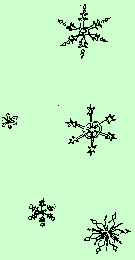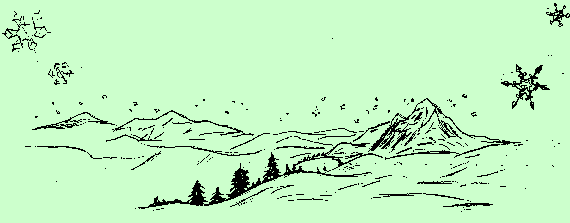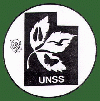|







|
. |



|
A Winter Message

 The sky darkens over the Pacific Coast. The wind pushes in a storm
of boiling dark clouds of water vapor and all the other ingredients
to be found in the atmosphere. Over the high coastal ranges, when
temperatures fall below freezing, the water vapor in the atmosphere
condenses on particles of dust to form white or translucent ice
crystals.
The sky darkens over the Pacific Coast. The wind pushes in a storm
of boiling dark clouds of water vapor and all the other ingredients
to be found in the atmosphere. Over the high coastal ranges, when
temperatures fall below freezing, the water vapor in the atmosphere
condenses on particles of dust to form white or translucent ice
crystals.

 Nature produces many strange and wonderful things, but none as
delicate as the ice crystal. Divine sculpture creates the snowflake
in an infinite variety of hexagonal forms, each with a beauty all
its own. Even broken fragments or clusters of them are no less
beautiful. Not only are the forms variable, but the sizes as well.
Many have been known to grow to several inches in diameter, and in
very still air snowflakes up to ten inches in diameter have been
reported.
Nature produces many strange and wonderful things, but none as
delicate as the ice crystal. Divine sculpture creates the snowflake
in an infinite variety of hexagonal forms, each with a beauty all
its own. Even broken fragments or clusters of them are no less
beautiful. Not only are the forms variable, but the sizes as well.
Many have been known to grow to several inches in diameter, and in
very still air snowflakes up to ten inches in diameter have been
reported.

 Each snowfall received during the winter has its own personality
and characteristics. Moisture content determines the snow density,
which depends upon the temperature at which it forms. At 20 degrees
below zero, a snowfall of four or five inches may have only a few
hundredths of an inch of water when melted. At zero, snows are
light and fluffy and will be squeaky underfoot. About fifteen
inches of such snow are needed to make an inch of water. Then there
is the "wet" type of snow, when snowflakes become moist and large
as temperatures approach 32 degrees. This type of snow, perfect for
a snowball fight or for making a snowman, may produce an inch of
water for every four to seven inches of snow depth.
Each snowfall received during the winter has its own personality
and characteristics. Moisture content determines the snow density,
which depends upon the temperature at which it forms. At 20 degrees
below zero, a snowfall of four or five inches may have only a few
hundredths of an inch of water when melted. At zero, snows are
light and fluffy and will be squeaky underfoot. About fifteen
inches of such snow are needed to make an inch of water. Then there
is the "wet" type of snow, when snowflakes become moist and large
as temperatures approach 32 degrees. This type of snow, perfect for
a snowball fight or for making a snowman, may produce an inch of
water for every four to seven inches of snow depth.

 Snow is welcome in Utah. It means winter sports and recreation,
beautiful vistas of snow-clad mountains, and most important of all,
when the spring thaw comes, it means millions of acre-feet of water
filling our reservoirs to be used for the benefit of all.
Snow is welcome in Utah. It means winter sports and recreation,
beautiful vistas of snow-clad mountains, and most important of all,
when the spring thaw comes, it means millions of acre-feet of water
filling our reservoirs to be used for the benefit of all.

 Members of Utah Nature Study Society are well aware of the value
of snow. Long weeks and even months of rainless days are not
disastrous if there has been a good store of winter snows slowly
melting. The released water makes its way to the valleys where
gardens, lawns and people enjoy its blessing. So let it snow!
Let it snow! Let it snow!
Members of Utah Nature Study Society are well aware of the value
of snow. Long weeks and even months of rainless days are not
disastrous if there has been a good store of winter snows slowly
melting. The released water makes its way to the valleys where
gardens, lawns and people enjoy its blessing. So let it snow!
Let it snow! Let it snow!

-- by Hans Rasmussen

|
|
|
|

